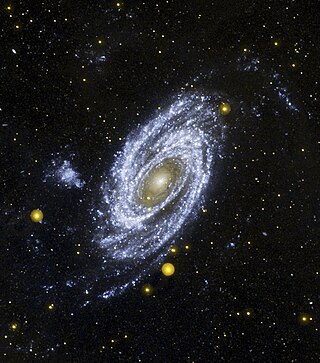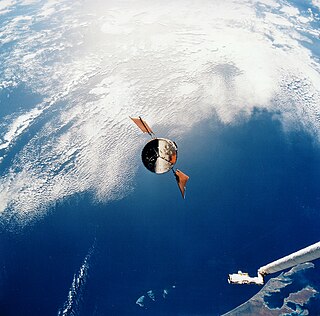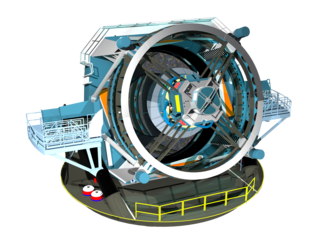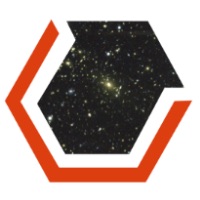Related Research Articles

Ultraviolet astronomy is the observation of electromagnetic radiation at ultraviolet wavelengths between approximately 10 and 320 nanometres; shorter wavelengths—higher energy photons—are studied by X-ray astronomy and gamma-ray astronomy. Ultraviolet light is not visible to the human eye. Most of the light at these wavelengths is absorbed by the Earth's atmosphere, so observations at these wavelengths must be performed from the upper atmosphere or from space.

The Hubble Deep Field (HDF) is an image of a small region in the constellation Ursa Major, constructed from a series of observations by the Hubble Space Telescope. It covers an area about 2.6 arcminutes on a side, about one 24-millionth of the whole sky, which is equivalent in angular size to a tennis ball at a distance of 100 metres. The image was assembled from 342 separate exposures taken with the Space Telescope's Wide Field and Planetary Camera 2 over ten consecutive days between December 18 and 28, 1995.

Observational astronomy is a division of astronomy that is concerned with recording data about the observable universe, in contrast with theoretical astronomy, which is mainly concerned with calculating the measurable implications of physical models. It is the practice and study of observing celestial objects with the use of telescopes and other astronomical instruments.

The High Speed Photometer (HSP) is a scientific instrument formerly installed on the Hubble Space Telescope. The HSP was designed to measure the brightness and polarity of rapidly varying celestial objects. It could observe in ultraviolet, visible light, and near infrared at a rate of one measurement per 10 microseconds. The design was novel in that despite being able to view through a variety of filters and apertures, it had no moving parts "except for electrons" as principal investigator Prof. Robert Bless was fond of saying. Filter and aperture selection was accomplished using image dissector tubes and the HST pointing system. It was functional from launch in 1990 until it was removed at the end of 1993, and it helped diagnose an issue with the Hubble's primary mirror.

International Ultraviolet Explorer, was the first space observatory primarily designed to take ultraviolet (UV) electromagnetic spectrum. The satellite was a collaborative project between NASA, the United Kingdom's Science and Engineering Research Council and the European Space Agency (ESA), formerly European Space Research Organisation (ESRO). The mission was first proposed in early 1964, by a group of scientists in the United Kingdom, and was launched on 26 January 1978 aboard a NASA Thor-Delta 2914 launch vehicle. The mission lifetime was initially set for 3 years, but in the end it lasted 18 years, with the satellite being shut down in 1996. The switch-off occurred for financial reasons, while the telescope was still functioning at near original efficiency.

V476 Cygni or Nova Cygni 1920 was a nova which occurred in the constellation Cygnus in 1920. It was discovered by William Frederick Denning, an English amateur astronomer, at 09:30 GMT on 20 August 1920, at which time it had a magnitude of 3.7. It reached a peak brightness of magnitude 1.7 on 23 August 1920. Its quiescent brightness is magnitude 17.09.

The Vera C. Rubin Observatory, previously referred to as the Large Synoptic Survey Telescope (LSST), is an astronomical observatory currently under construction in Chile. Its main task will be carrying out a synoptic astronomical survey, the Legacy Survey of Space and Time. The word synoptic is derived from the Greek words σύν and ὄψις, and describes observations that give a broad view of a subject at a particular time. The observatory is located on the El Peñón peak of Cerro Pachón, a 2,682-meter-high mountain in Coquimbo Region, in northern Chile, alongside the existing Gemini South and Southern Astrophysical Research Telescopes. The LSST Base Facility is located about 100 kilometres (62 mi) away by road, in the town of La Serena. The observatory is named for Vera Rubin, an American astronomer who pioneered discoveries about galaxy rotation rates.

The Cosmic Origins Spectrograph (COS) is a science instrument that was installed on the Hubble Space Telescope during Servicing Mission 4 (STS-125) in May 2009. It is designed for ultraviolet (90–320 nm) spectroscopy of faint point sources with a resolving power of ≈1,550–24,000. Science goals include the study of the origins of large scale structure in the universe, the formation and evolution of galaxies, and the origin of stellar and planetary systems and the cold interstellar medium. COS was developed and built by the Center for Astrophysics and Space Astronomy (CASA-ARL) at the University of Colorado at Boulder and the Ball Aerospace and Technologies Corporation in Boulder, Colorado.

Astrosat is India's first dedicated multi-wavelength space telescope. It was launched on a PSLV-XL on 28 September 2015. With the success of this satellite, ISRO has proposed launching AstroSat-2 as a successor for Astrosat.

The Dark Energy Survey (DES) is an astronomical survey designed to constrain the properties of dark energy. It uses images taken in the near-ultraviolet, visible, and near-infrared to measure the expansion of the universe using Type Ia supernovae, baryon acoustic oscillations, the number of galaxy clusters, and weak gravitational lensing. The collaboration is composed of research institutions and universities from the United States, Australia, Brazil, the United Kingdom, Germany, Spain, and Switzerland. The collaboration is divided into several scientific working groups. The director of DES is Josh Frieman.

The Spektr-UV, also known as World Space Observatory-Ultraviolet (WSO-UV), is a proposed ultraviolet space telescope intended for work in the 115 nm to 315 nm wavelength range. It is an international project led by Russia (Roscosmos), with participation from Spain and Japan. The launch had initially been planned for 2007, but has since been continually delayed; as of February 2023, the launch is planned for the end of 2028 atop an Angara A5M rocket from Vostochny Cosmodrome.

A Pea galaxy, also referred to as a Pea or Green Pea, might be a type of luminous blue compact galaxy that is undergoing very high rates of star formation. Pea galaxies are so-named because of their small size and greenish appearance in the images taken by the Sloan Digital Sky Survey (SDSS).

Time-domain astronomy is the study of how astronomical objects change with time. Though the study may be said to begin with Galileo's Letters on Sunspots, the term now refers especially to variable objects beyond the Solar System. Changes over time may be due to movements or changes in the object itself. Common targets included are supernovae, pulsating stars, novas, flare stars, blazars and active galactic nuclei. Visible light time domain studies include OGLE, HAT-South, PanSTARRS, SkyMapper, ASAS, WASP, CRTS, and in a near future the LSST at the Vera C. Rubin Observatory.

ULTRASAT is a space telescope in a smallsat format with a large field of view, 210 square degrees, that will detect and monitor transient astronomical events in the near-ultraviolet (220–280 nm) spectral region. ULTRASAT will observe a large patch of sky, alternating every six months between the southern and northern hemisphere. The satellite will be launched into geosynchronous orbit in early 2026. All ULTRASAT data will be transmitted to the ground in real time. Upon detection of a transient event, ULTRASAT will provide alerts within 20 minutes to other ground-based and space telescopes to be directed to the source for further observation of the event in other wavelength bands.

Kevin France is an astrophysicist and assistant professor in the Department of Astrophysical and Planetary Sciences at the University of Colorado. His research focuses on exoplanets and their host stars, protoplanetary disks, and the development of instrumentation for space-borne astronomy missions.

HD 203030, also known as V457 Vulpeculae, is a single, yellow-orange hued star with a sub-stellar companion in the northern constellation of Vulpecula. The designation HD 203030 is from the Henry Draper Catalogue, which is based on spectral classifications made between 1911 and 1915 by Annie Jump Cannon and her co-workers, and was published between 1918 and 1924. This star is invisible to the naked eye, having an apparent visual magnitude of 8.45. It is located at a distance of 128 light years from the Sun based on parallax, and is drifting closer with a radial velocity of −17 km/s.

The Super-pressure Balloon-borne Imaging Telescope (SuperBIT) is a highly stabilized, high-resolution telescope that operates in the stratosphere via NASA's superpressure balloon (SPB) system. At 40 km altitude above sea level, the football-stadium-sized balloon carries SuperBIT to a suborbital environment above 99.2% of the Earth's atmosphere in order to obtain space-quality imaging. As a research instrument, SuperBIT's primary science goal is to provide insight into the distribution of dark matter in galaxy clusters and throughout the large-scale structure of the universe. As demonstrated by numerous test flights, the survey data generated by SuperBIT is expected to have similar quality and data collection efficiency as the Hubble Space Telescope while complementing surveys from other up-and-coming observatories such as the James Webb Space Telescope (JWST), the Vera C. Rubin Observatory, and the Nancy Grace Roman Space Telescope.
References
- ↑ Côte, Patrick; Scott, Alan; Balogh, Michael; Buckingham, Ron; Aldridge, David; Carlberg, Ray; Chen, Weiguo; Dupuis, Jean; Evans, Clinton; Drissen, Laurent; Fraser, Wes; Grandmont, Frederic; Harrison, Paul; Hutchings, John; Kavelaars, JJ; Landry, John-Thomas; Lange, Christian; Laurin, Denis; Patel, Tarun; Pillay, Venka; Piche, Louis; Rader, Andres; Robert, Carmelle; Sawicki, Marchin; Sorba, Robert; Theriault, Guillaume; Van Waerbeke, Ludovic (2012). "CASTOR: the Cosmological Advanced Survey Telescope for Optical and Ultraviolet Research". In Clampin, Mark C.; Fazio, Giovanni G.; MacEwen, Howard A.; Oschmann, Jacobus M. (eds.). Space Telescopes and Instrumentation 2012: Optical, Infrared, and Millimeter Wave. Vol. 8442. SPIE. p. 844215. doi:10.1117/12.926198. S2CID 119902782 . Retrieved 2022-07-04.
- 1 2 3 "CASTOR Mission Specifications" . Retrieved 2022-07-04.
- 1 2 "CASTOR: A Flagship Canadian Space Telescope" . Retrieved 2022-07-04.
- ↑ "Canadian Astronomy Long Range Plan" (PDF). Retrieved 2022-07-04.
- ↑ "CASTOR Science" . Retrieved 2022-07-04.
- ↑ Graham, Melissa L.; Connolly, Andrew J.; Wang, Winnie; Schmidt, Samuel J.; Morrison, Christopher B.; Ivezić, Željko; Fabbro, Sébastien; Côté, Patrick; Daniel, Scott F.; Jones, R. Lynne; Jurić, Mario; Yoachim, Peter; Kalmbach, J. Bryce (2020-05-13). "Photometric Redshifts with the LSST. II. The Impact of Near-infrared and Near-ultraviolet Photometry". The Astronomical Journal. American Astronomical Society. 159 (6): 258. arXiv: 2004.07885 . Bibcode:2020AJ....159..258G. doi: 10.3847/1538-3881/ab8a43 . ISSN 1538-3881. S2CID 215814361.
- ↑ Fantin, Nicholas J.; Côté, Patrick; McConnachie, Alan W. (2020-09-09). "White Dwarfs in the Era of the LSST and Its Synergies with Space-based Missions". The Astrophysical Journal. American Astronomical Society. 900 (2): 139. arXiv: 2007.01312 . Bibcode:2020ApJ...900..139F. doi: 10.3847/1538-4357/aba270 . ISSN 1538-4357.